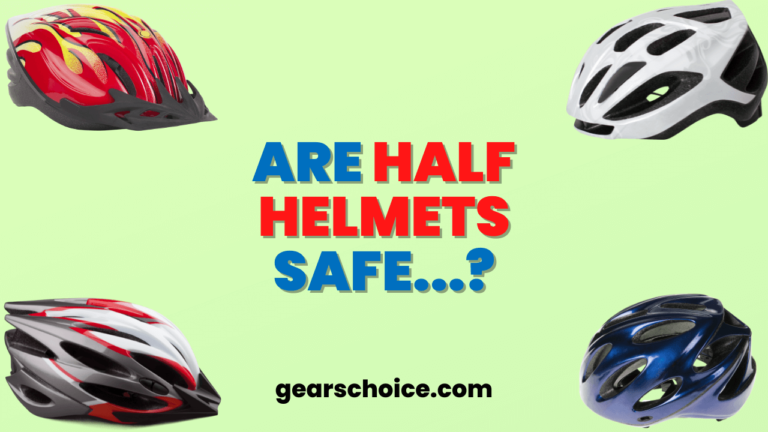How To Tell If Motorcycle Helmet Is Too Small [Everything Explained]
It can be dangerous to ride a motorcycle with a helmet that is too small, especially if you are new to motorcycling. You won’t be protected in case of a crash if your helmet is too small.
A properly fitting motorcycle helmet will help protect your head if you get into an unexpected crash. The shell usually consists of foam material on the inside and plastic material on the outside.
Flying through the air will not be a problem with the heavy-duty strapping system. There is a wide range of motorcycle helmet sizes available, from extra-extra small up to 5x large for adults.
Make sure that you choose the right size when you’re out shopping. Here are some tips to help you pick the right size helmet and tell if a helmet is too small.
![How To Tell If Motorcycle Helmet Is Too Small [Everything Explained] 1 How To Tell If Motorcycle Helmet Is Too Small](https://gearschoice.com/wp-content/uploads/2022/09/How-To-Tell-If-Motorcycle-Helmet-Is-Too-Small-1024x576.png)
How to Tell If a Motorcycle Helmet Is Too Small?
When a bike helmet is too small, there are a variety of ways to tell:
Doesn’t Fit Snugly
It is important that the helmet fits snugly so that it does not feel too tight. Make sure the helmet is slightly loose when you wear it for the first time.
Therefore, your cheeks should not feel tight. When the straps are loose, and you are holding the helmet in one position, it will be impossible to move your head sideways or up and down.
It is, however, important to avoid wearing loose-fitting headgear since the straps will move around when tightened.
It may feel too loud when riding against the wind, and it can come off when you’re unaware.
Pressure Points
Furthermore, have you experienced discomfort or painful pressure points while wearing the helmet?
A small headgear will certainly cause this problem if it is not made to fit your head shape.
If you experience discomfort at the pressure points on the sides, it could be a result of the helmet being both too small and too oval.
The headgear may not be long enough if you feel pressure in the back of your head at the base.
If you want to see if it feels comfortable indoors for about 30 minutes before you take it out, try it on first.
Red Forehead
A red forehead is thought to be a typical mark left by a new helmet by some people. Their skin condition is believed to be a skin condition by others.
The condition isn’t like that. It is most often caused by wearing headgear that is not suited to your head shape, resulting in a red forehead.
Due to their lack of experience, new riders usually encounter it. In cases of accidents involving around-the-oval helmets, your forehead gets red.
What can you do to improve the fit of a motorcycle helmet? The foam material can be reshaped to provide a better fit.
Measure Your Head for the Right Size
It is important to take accurate measurements of your head to prevent purchasing too small helmets. This activity involves measuring with a measuring tape and string.
Measure your head’s widest part
Make sure you wrap the soft tape around your head’s widest part. Place it about 1/4 to 1/2 inch above your eyebrow line.
You can also use a string instead of a measuring tape if you do not have one handy. You won’t get the right measurement if it’s loose or has flex.
Using the sizing chart, relate the Measurements
As soon as you have the measurement, you can compare it with the sizing chart. The size chart is usually included with each product on the product page.
Use the chart to determine what size helmet you need. It will show you how much your head measures in centimeters or inches.
Select the Ideal Shape
A person’s headgear size is influenced by its shape. Helmets should be chosen according to their fit without accounting for discomfort or pain in the head.
Try Out the Helmet
A local store may have helmets you can purchase. Then you will see if there are any signs that the helmet is too small. The helmet will be able to be tested in sufficient time.
A feeling in your hand tells you if it’s too small or not. A return policy should be in place if the helmet size is incorrect during an online purchase.
Fit the forehead and cheeks of the helmet properly when wearing it. In order for your brow pads to fit comfortably on your forehead, there shouldn’t be any space between them.
The gap around the crown of your head should be observed if you are wearing a helmet for the first time.
Any extra room would be helpful. Putting two fingers inside, there would be too much space. A tight fit makes you feel uncomfortable.
Around your cheeks, you feel constant pressure. Cheek muscles are overworked when wearing a small helmet.
Choosing the Perfect Helmet Style
The style of the helmet is one of the most important factors to consider. A motorcycle helmet can be divided into three main categories: open-face, full-face, or half-face.
The most protective helmet is a full-face helmet. Including your jaw and cheeks, they cover your entire head. A full-face helmet is recommended for riding on the street.
Open-face helmets do not cover jaws and cheeks. The upper back of these helmets offers more protection than the top of the head, but they are more comfortable to wear during hot weather.
You should wear an open-face helmet if you’re riding off-road. You won’t get much protection from a half helmet since it only covers your head.
Hot weather is when they’re most comfortable, but they’re not the safest option. A half helmet is a good option for riders in hot climates.
Following your choice of helmet style, you can begin shopping for one that suits you best.
It is possible to choose from a wide variety of brands and styles of helmets. You should find one that is comfortable and fits well.
What is your Head Shape?
Getting a motorcycle helmet that fits your head shape properly is one of the biggest challenges most new riders face when buying their first helmet.
It is very important to consider the shape of the headgear. If the liners are too large, you may want to try switching them to a small size.
If you wear the wrong shape, none of these adjustments will help. Taking a look at some head shapes will allow you to determine the best design for you.
Helmets are generally classified according to three general head shapes: intermediate oval, long oval, and round oval.
Round oval heads have almost the same front-to-back measurement and about the same width from ear to ear as they have length.
The most common shape is an intermediate oval. Front-to-back head measurements are longer than ear-to-ear measurements with this shape.
It is common for people with long oval shapes to have longer head shapes from forehead to back.
Try on as many matching helmet models as you can once you are aware of your head shape.
Moreover, various brands and models may not work with your head due to the unique shape of each head. The fit should be snug without causing pain or pressure.
Frequently Asked Questions (FAQ’s)
How tight should a motorbike helmet be?
It is recommended that helmets should fit snugly against the wearer’s head without causing pressure points.
In order to ensure a smooth ride, there should be no ups and downs or side-to-side movements.
Don’t let it get too tight, but don’t let it get too loose either.
How to check if a helmet fits you properly?
Wearing a helmet should feel snug and comfortable against your forehead and fit snugly on your head.
Hold the helmet in both hands, one on each side, and rotate it from side to side by holding your head steady.
Why does my motorcycle helmet hurt my head?
Having a helmet that hurts your head is not the result of it being too small. You may need to let the helmet break in if it is the wrong size for your head.
There is no standard fit for helmets, and each one is made differently. It is important that your helmet fits snugly and firmly.
Final Verdict
A motorcycle helmet that is too small can be easily identified by now. Uncomfortable fit, painful pressure points, and red forehead are signs of wearing a helmet that’s too small.
Fit and comfort are crucial when choosing a helmet. As a result, you will be fully protected in the event of an unfortunate incident on the road.
Fitting a motorcycle helmet correctly may be challenging, but its comfort will not be compromised.
In order to feel your face moving with the helmet, you have to move your headgear in the same manner. Not too much pressure should be applied to your cheeks.
Trying on a new helmet for 30 minutes or so will help you determine if it fits appropriately. The pressure points will probably worsen within that time if you get hot spots.
You should feel more confident riding your bike once you find a helmet that fits perfectly.
![How To Tell If Motorcycle Helmet Is Too Small [Everything Explained] 2 Gears Choice Author](https://gearschoice.com/wp-content/uploads/2022/09/James-Dean.jpg)
Hi, I’m James Dean. My motorbike obsession started at age seven with a 50cc bike, and I’ve been riding ever since.
From motocross in my teens to cruising and snowmobiling today, I’ve got over 15 years of experience.
As a mechanical engineer and passionate rider, I founded gearschoice.com to share my insights and help you find the best motorcycle gear.

![How To Test Auto Darkening Welding Helmet [Complete Guide] 3 How To Test Auto Darkening Welding Helmet [Complete Guide]](https://gearschoice.com/wp-content/uploads/2022/09/How-To-Test-Auto-Darkening-Welding-Helmet-1-768x432.png)



![How To Clean A Motorcycle Helmet Visor? [Simple 9 Steps] 11 How To Clean A Motorcycle Helmet Visor](https://gearschoice.com/wp-content/uploads/2022/02/How-To-Clean-A-Motorcycle-Helmet-Visor-768x432.jpg)
